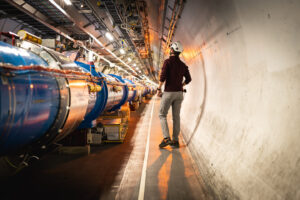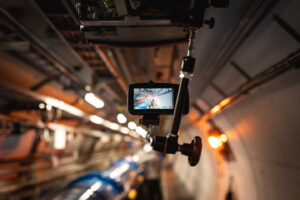In fifteen months’ time, the world’s largest particle accelerator should be running at maximum energy for the first time. At CERN, the year 2021 will be marked by the gradual restart of the LHC accelerator in March 2022, after three years of intensive work.
The so-called Long Shutdown 2 (LS2) of the LHC and its injector complex began two years ago, in early 2019. Since then, sweeping upgrades to the accelerator complex and key maintenance work have resulted in a rejuvenated accelerator complex with injectors fit for a decade or more of high brightness beam production. In the three-year Run 3, the LHC is expected to deliver twice as many collisions as in all previous years combined.
Preliminary highlight of the LHC program was the discovery in 2012 of the Higgs particle, the long sought-after keystone of the standard model of particle physics. Since then, much of the LHC’s research has focused on further exploring this crucial particle, also at Nikhef.
At the end of last year, the ceremonial key of the Super Proton Synchrotron (SPS) was handed over to operations, the LHC’s most important initial accelerator. This happened only a little later than planned. ‘Thanks to the hard work, dedication and flexibility of many,’ says head of the CERN accelerator group, Rende Steerenberg.
He emphasizes the thoroughness with which special measures were taken to ensure the safety of personnel during the COVID-19 pandemic. A large number of physicists, engineers and technicians strived day-in day-out to complete the upgrade and consolidation of the accelerator complex safely and efficiently following the spring lockdown.
Super synchrotrons
In the 27 kilometer long LHC itself, all 1232 dipole magnet interconnections were opened underground and their electrical insulation consolidated, so that the accelerator can now safely operate at the full 7 TeV energy. The LHC was delivered in 2008, but was damaged in September of that year following a short circuit in the system, which led to an explosion. After repairs, the machine was not yet used at maximum collision energy, just to be on the safe side.
To this end, the cryogenic team cooled the first of the eight sectors of the LHC to the operational temperature of 1.9 K on 15 November 2020, while five other sectors were cooled in parallel and the entire machine is set to be cold by spring.
The first beam of the new Linac 4 was injected into the upgraded Proton Synchrotron Booster (PSB) on December 7. The PSB will undergo a commissioning period before the beam is injected into the Proton Synchrotron (PS) on March 1st of this year. It is then the PS’s turn to be commissioned before the beam is sent to the Super Proton Synchrotron (SPS) on 12 April.
After handing over to the electrical quality-assurance team for the final electrical tests, powering tests and a long campaign of quench training will take place to enable the LHC magnets to support fields in excess of those required during Run 2, when the beam energy was 6.5 TeV. The test beams are due to circulate in the LHC at the end of September 2021, only four months later than was planned before the COVID-19 pandemic struck.
Detector work
In parallel to the work on CERN’s accelerator infrastructure, experimental physicists are working hard to complete major detector upgrades which anticipate the stringent requirements of triggering and reconstructing events at the upgraded LHC. The refurbishment of the ATLAS detector’s trigger electronics for the liquid-argon-calorimeter is progressing quickly and the construction of the muon detector’s two new ‘Small Wheels’ is set to be completed in October 2021. Nikhef is a partner in the ATLAS program.

In the ALICE detector, a second Nikhef partner, the time projection chamber has been reinstalled, and work is underway on the installation of the new muon forward tracker of the detector. A new 10 GPixel inner-tracker detector will be installed in the first quarter of 2021.
Meanwhile, the next steps for a significant revamp of the LHCb detector are the mounting of new vertex-locator modules and the first sensitive detector parts of the new ring-imaging Cherenkov detector during the first months of 2021. Nikhef contributes to the new vertex detector of LHCb.
Elsewhere on the CERN complex, various experiments with antimatter will be restarted as early as the summer of 2021.
No changes have been made to the LHC schedule after 2022. Following the completion of Run 3, the third Long Shutdown will begin at the start of 2025 for the LHC, and in early 2026 for the injector chain. Mid 2027, the LHC accelerator should come into operation as a high luminosity machine, the HL-LHC.
